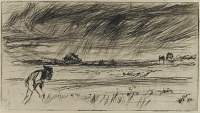Etchings Institutions search term: wunderlich
The Storm | ||
| Number: | 81 | |
| Date: | 1861 | |
| Medium: | drypoint | |
| Size: | 156 x 286 mm | |
| Signed: | 'Whistler.' at lower right | |
| Inscribed: | '1861.' at lower right | |
| Set/Publication: | 'Cancelled Plates', 1879 | |
| No. of States: | 3 | |
| Known impressions: | 36 | |
| Catalogues: | K.81; M.83; T.74; W.77 | |
| Impressions taken from this plate (36) | ||
KEYWORD
TITLE
'The Storm - (Ridley)' (1870s, Whistler). 1
'The Storm' (1874, Whistler). 2
'The Storm' (1874, Ralph Thomas, Jr (1840-1876)). 3
'The storm' (1875, Whistler). 4
'The Storm (Ridley)' (1881, Union League Club). 5
'The Storm' is the title published by Whistler and generally accepted. 'Ridley' was probably added by Whistler as a piece of personal information for the buyer of the drypoint, Samuel Putnam Avery (1822-1904), and was not the full title.
2: London Pall Mall 1874 (cat. no. 1).
3: Thomas 1874 (cat. no. 74).
4: Whistler to W. C. Alexander, [March/April 1875?], GUW #07573.
5: New York 1881 (cat. no. 106).
DESCRIPTION
SITTER
 ), probably in the early 1870s, and this impression was shown in New York in 1881 under that title - 'The Storm (Ridley)'. 6
), probably in the early 1870s, and this impression was shown in New York in 1881 under that title - 'The Storm (Ridley)'. 6
6: New York 1881 (cat. no. 106). Gatty 1974 ; Gatty 1981 .
SITE
DISCUSSION
7: Los Angeles 1984 (cat.no. 6).
